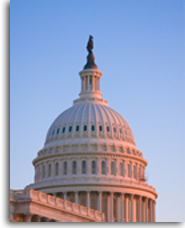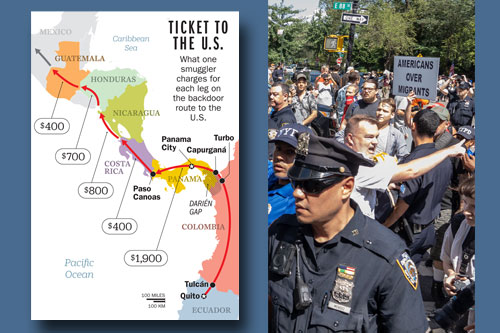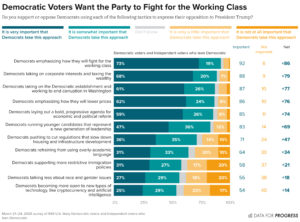If you were looking for a solid indictment of the Trump Administration’s disastrous policies, which can also serve as a template for writing a first-rate opinion column about current politics, E. J. Dionne, Jr. has it in “The night the tide turned against Trump and Musk,” cross-posted here from The Washington Post:
Here’s what evidence can do for you.
We learned this week that though it’s fashionable to bury Democrats under a pile of d-words — denial, division, despondency, disengagement and that old favorite, disarray — it’s Republicans who will soon have to face up to President Donald Trump’s chaotic, petrifying, government-wrecking, rights-destroying opening act.
Democrats in Washington have something to learn, too: They need to catch up with their supporters around the country who are angry, focused, mobilized and absolutely right to demand that everything possible be done to prevent Trump from destroying constitutional democracy, free speech, independent private institutions and public agencies that he and Elon Musk have absolutely no mandate to tear down.
One Democrat plainly got the message: Sen. Cory Booker (D-New Jersey) electrified Trump’s foes by holding the Senate floor for a record-breaking 25 hours and four minutes on Monday and Tuesday to underscore Trump and Musk’s “complete disregard for the rule of law, the Constitution and the needs of the American people.”
Tuesday’s elections in Wisconsin and Florida should upend easy and lazy storylines that took hold after Trump’s victory last November sank Democrats into the mire of recriminations. Democrats in Washington might be feuding, but their supporters elsewhere are united in a mission to contain and defeat Trump. The president might think he’s loved by his party, but many who voted for him last year are uneasy about the impact of his erratic policymaking and Musk’s wrecking crew.
In the contest for a swing seat on the Wisconsin Supreme Court, the victory of Susan Crawford, the liberal circuit court judge backed by Democrats, was powered by an extraordinary mobilization against Trump and — especially — Musk, who poured an estimated $25 million into the campaign to defeat her.
Musk used his money to try to get low-turnout Trump voters to cast a ballot in the sort of race they usually skip. Instead, the billionaire turned himself into a perfect villain for Democrats. At one point, Crawford referred to her conservative opponent Brad Schimel as “Elon Schimel.” That said it all. A state that narrowly backed Trump in 2024 swung sharply away. Crawford defeated Schimel by 10 points.
And Republicans should forget about writing off the race as a local fluke. “It’s really much more than local,” none other than Trump said in an attempt before the election to rally his loyalists to come out for Schimel. “The whole country is watching.” Yes, it is. Musk went even further, telling the crowd at a rally last weekend that the judgeship race “could decide the future of America and Western civilization.” Democratic voters, it turns out, agreed with that.
In Florida, Republicans hung on to two House seats in special elections in very Trumpy areas, but they had to withstand swings of roughly 17 and 19 points toward the Democrats. Even Republican House members and senators who imagine themselves safe in 2026 will start pondering the price of slavish loyalty to Trump. Breaking with him might have its costs inside the GOP, but now primaries might matter less to their fate than defeat in a general election.
The danger to politicians in both parties is that they will underplay the importance of these results. What happened in Wisconsin and Florida reflects something the polls say is true nationwide: Trump is doing far more to mobilize his opponents than to rally his supporters.
A March 22-25 Economist-YouGov poll captured what’s going on: Though 29 percent of those surveyed strongly approved of Trump’s performance, 40 percent strongly disapproved. Democrats are clearly more stirred than Republicans: Though 67 percent of Republicans strongly approved of Trump, 80 percent of Democrats strongly disapproved.
It’s rare for 80 percent of Democrats to agree on anything. No wonder Sen. Bernie Sanders (I-Vermont) and Rep. Alexandria Ocasio-Cortez (D-New York) have become heroes far beyond the party’s progressive wing and have drawn such enormous crowds for their anti-Trump, anti-oligarchy rallies.
This helps explain why another trope about our politics is wrong. It’s simply not true that Trump’s opponents are less mobilized than they were at a comparable point in his first spell in office back in 2017. On the contrary, a study released last month by the Crowd Counting Consortium found “more than twice as many street protests than took place during the same period eight years ago.” The researchers concluded “that resistance against Trump’s agenda in America is not only alive and well. It is savvy, diversifying and probably just getting started.”
If Trump has moved with lightning speed in Washington, so have his opponents in what Republicans like to call “real America.”
Democratic leaders at the state and local level testify to the grassroots yearning for any opportunity they can find to engage. “So many Democrats — and, really, all who follow the news in a serious way — feel they’re bring punched in the face every single day,” Ben Wikler, chairman of the Wisconsin Democratic Party, told me before Tuesday’s vote. “They want to channel their outrage and actual fear into a surge of electoral energy.”
What do these citizens want from national leaders? “A sense of urgency and alarm,” he replied. “They want the danger called out.”
The same dynamism can be found in Pennsylvania, where Democrat James Malone, the mayor of East Petersburg, won a March 25 special election for a state Senate seat in a Lancaster County district that voted for Trump by 15 points last year.
Malone told me the engagement his campaign unleashed belied talk of “fatigue” among rank-and-file Democrats. “Every single person we talked to was ready for action,” he said. Even voters who say they still support Trump, he said, “don’t like the chaos and don’t like the way he’s cutting aid to veterans and to seniors, don’t like the effect his policies are having on farmers.”
Though he’s from a pro-Trump area, Malone said Democratic leaders “ought to be up in arms” about Trump’s abuses on “legal issues and precedents.” He added, “We should be doing a lot more than holding a monotone press conference.”
Democrats in the House and Senate would, of course, insist that they are doing more than speaking monotonically. But some in their ranks were slow to embrace the imperative to stand forcefully against Trump’s abuses and were too inclined to point out the power they lacked as a congressional minority. What their voters want to hear is that they’ll aggressively use whatever power they do have to stop or slow Trump and Musk. If you wonder why approval ratings of the Democratic Party are at a record low, consider that a party in the doldrums is far less appealing than a party putting up a fight.
Booker’s oratorical feat on the Senate floor was a powerful response to his party’s hunger for forceful action, and he made clear that he was answering its call. “I’ve been hearing from people all over my state and indeed all over the nation,” he said, “calling upon folks in Congress to do more, to do things that recognize the urgency, the crisis of the moment.”
It was significant that Senate Minority Leader Charles E. Schumer (D-New York), who came under fire from his party for his controversial decision last month to vote with Republicans to prevent a government shutdown, joined Booker on the Senate floor to praise his colleague’s “strength and conviction.” Schumer came back near the end of Booker’s filibuster to announce he had shattered the Senate speaking record.
Schumer insists he made the right call on the GOP budget bill, given the extensive damage Trump and Musk could have inflicted with the enhanced power a shutdown would have conferred on the executive branch. But in an interview, Schumer made clear his intention to increase pressure on Trump, went out of his way to praise Sanders and used his colleague’s language to argue that the Trump administration embodies rule by an “oligarchic class.”
“It was a message of the progressive left,” Schumer said. “Now it works for everybody,” referring to Democrats across the ideological spectrum. Schumer is looking to bring competing critiques of the administration together by linking Trump’s threats to democracy to the economic interests of middle- and working-class voters. “A democracy is not just a system of abstract laws,” he said. “It is a system where people have the power to protect themselves.”
Of course, Democrats have a lot of work to do to win back working-class voters, especially Latinos, to bring their moderate and progressive wings together, and to make a generational leap to new leadership. But Tuesday’s election results sent a message to pundits and Republicans alike: The party that truly needs to start worrying is the GOP. The swing voters who elected Trump did not intend for their ballots to be used as a mandate for his abuses of power, his threats to civil liberties or his chaotic approach to governance. If there ever was a Trump honeymoon, it ended decisively on Tuesday.









